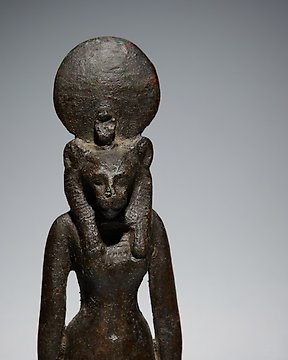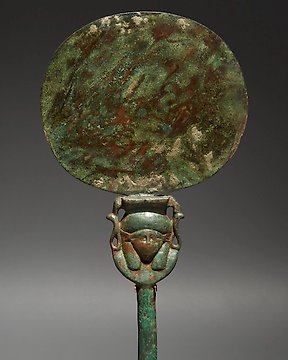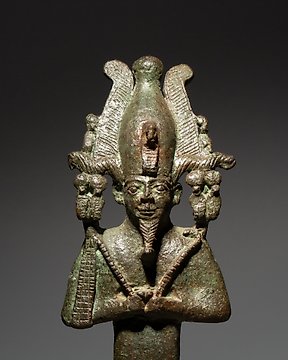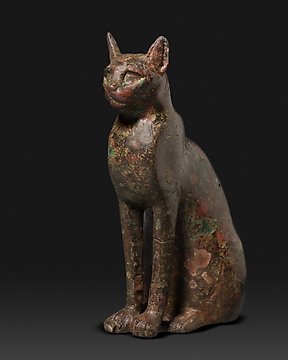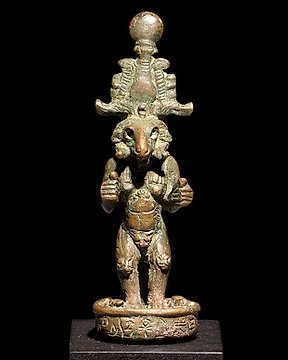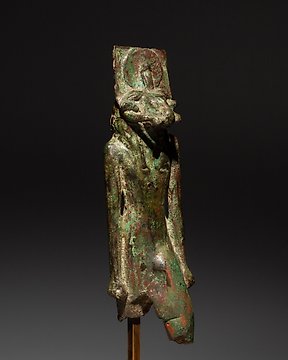All OK and with very fast shipping.
查看翻譯古埃及 青銅色 帶翅膀的女神伊西斯。晚期,西元前 664 - 341 年。 12 公分高。西班牙出口許可證。
編號 84871655
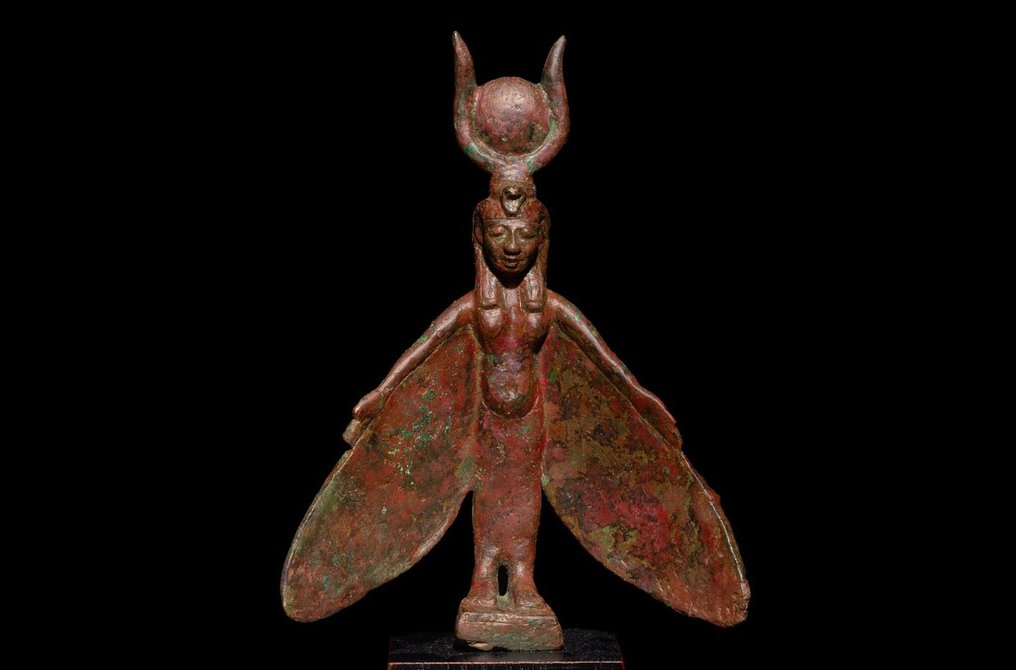
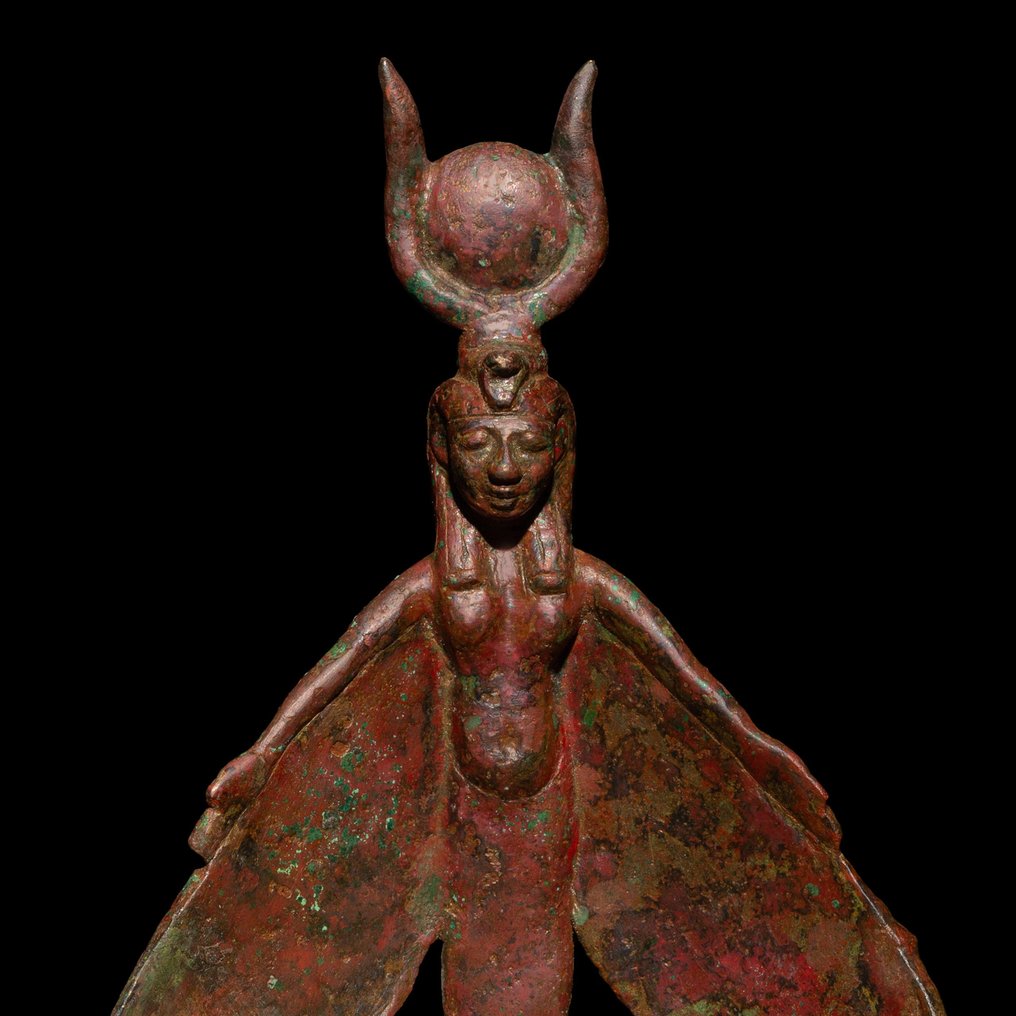

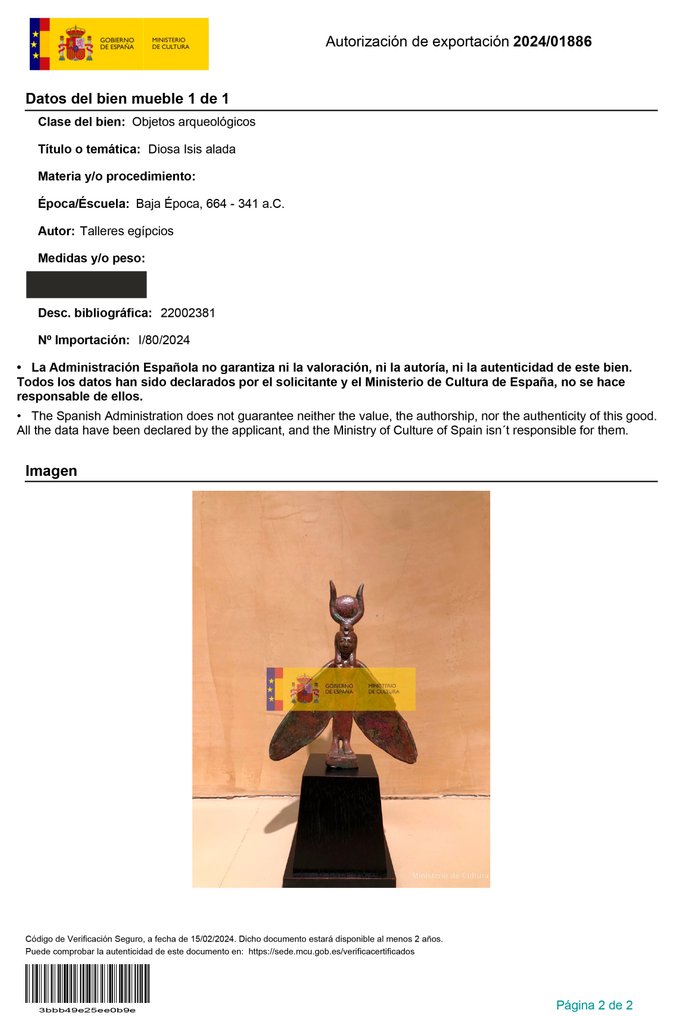
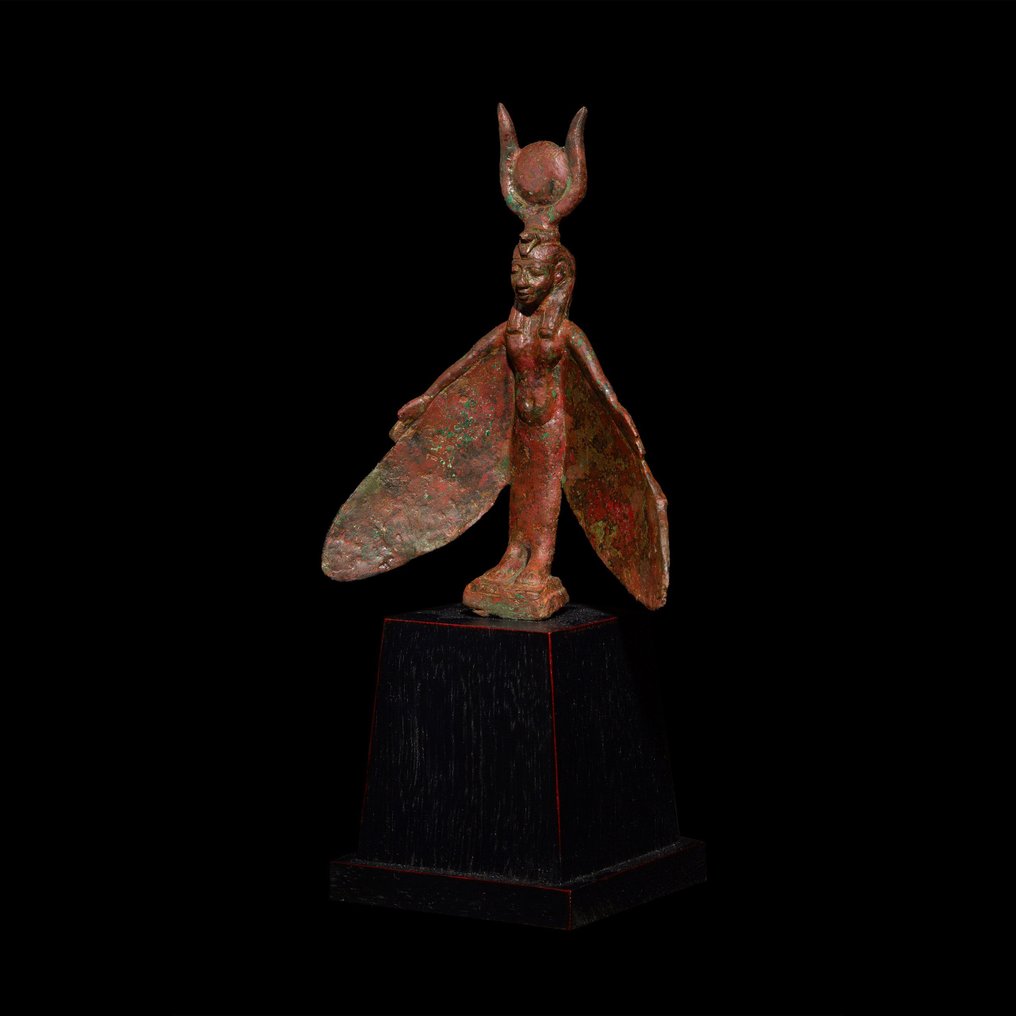
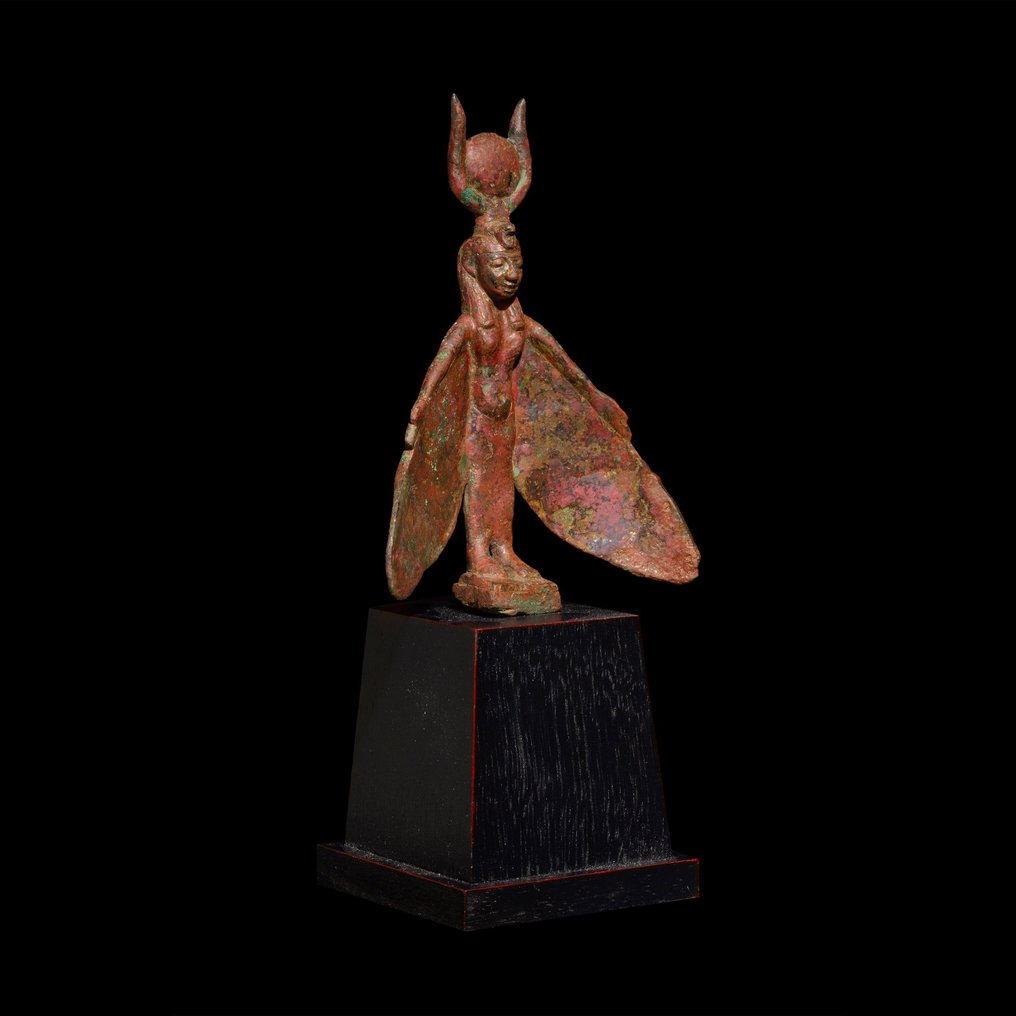
Winged Goddess Isis.
Ancient Egypt, Late Period, 664 - 332 BC
MATERIAL: Bronze.
DIMENSIONS: 13 cm height and 20.5 cm with the stand.
PROVENANCE: Private collection, Louviers, France, 1960 – 1980.
CONDITION: Good condition in general, with restoration on the tip of the crown horns and on the lower part of the right wing.
DESCRIPTION:
A statuette made of bronze by lost wax casting represents the goddess Isis with large falcon wings under her arms, which she extends towards the front in a gesture of protection. The symbolic and magical importance of the wings is reflected in their large size, which also translates into remarkably long arms about the rest of the body. The wings show meticulous work on their external side, based on fine incisions that represent the plumage. The figure appears standing, dressed in a fine tight tunic common in representations of goddesses, which reveals anatomical details such as the profile of the belly, the navel, and the nipples, a feature that is repeated in other similar pieces (fig. 1).
On her head, Isis wears a headdress made up of cow horns that frame a solar disk, with the urea on her forehead. This headdress, which Isis shares with the goddess Hathor starting in the New Kingdom, alludes to her character as the goddess of fertility, as well as her status as the daughter of Ra, the solar god par excellence in Egyptian religion. At the back, on the crown of the head, there is a circular ornament that stands out, engraved, on the parallel strands of the tripartite wig. On the front, this wig appears to cover a large part of the forehead, gathered behind the ears and with the two ends resting on the chest. The face of the goddess is delicate despite the small size of the statuette; rounded in shape, with full cheekbones and a small, half-open mouth, with thick lips, large almond-shaped eyes, and a nose that narrows towards its base.
Compared to the torso, which worked with notable volume and attention to detail, the lower extremities are flat; It is probably because a second character would be placed in front of the figure of Isis, whom the goddess magically protects with her wings. Isis Pterophorus (winged Isis) is the protector of Osiris and is usually represented as seen here, with her wings spread downward, flanking the body of her brother-husband (fig. 2). At a typological level it is a scarce model, based on early texts in which Isis and her sister Nephthys, in the form of long-winged falcons, mourn Osiris and protect his reunified body after its dismemberment. They project the shadow of their wings onto it, which they move to direct the air toward its nose and thus renew its life (fig. 3). It is possible, therefore, that the statuette under study was part of a sculptural group made up of three figures, with winged Nephthys in the same position, facing Isis, and Osiris in the center protected by both. The three figures would be placed on an independent bronze or wooden base.
There are also known examples in which Isis appears with this winged-protective character linked to other deities, such as the bull Apis (fig. 4). This type of statuette with Isis Pterophorus was often part of removable groups (fig. 5), with the different figures attached to the same base using a spike (fig. 6), or placed on the same surface, but with different bases. (fig. 7). In any case, the image of winged Isis had an important funerary function; As the Lady of Magic, she had the power to bring the dead back to life, so her magical protection after death was invoked through all types of images placed in the tombs.
The Egyptian goddess Ast, Isis for the Romans, is a celestial deity whose cult has its origins in the Nile Delta. The myth tells that it was she who searched for and recovered the torn body of her husband Osiris, murdered by their brother. Seth. Isis reconstructed the corpse of Osiris with the help of Anubis and Nephthys, and impregnated with his body conceived Horus, who would later avenge the death of his father. Isis was therefore the main deity of Egyptian funerary rituals, considered a protector of the dead. Known by the epithet of the Great Magician, in addition to recomposing the body of her deceased husband, Isis created by magic the first cobra, whose poison she used to force Ra, the Sun, to reveal her secret name. This gave him enormous power over the sun god, power which he shared with his son Horus to help legitimize his right to the throne of Osiris. This magical feat saw the initiation of a secret cult described by Apuleius in The Golden Ass, key in the development of the cult of Isis outside of Egypt.
BIBLIOGRAPHY:
- BIANCHI, R. S. Les bronzes égyptiens. Gandur Foundation for Art, Till Schaap. 2014.
- BOTHMER, B.W. von. Egyptian Sculpture of the Late Period. 700 B.C. to A.D. 100. The Brooklyn Museum. 1960.
- HART, G. The Routledge Dictionary of Egyptian Gods and Goddesses. Routledge. 2005.
- LESKO, B. The Great Goddesses of Egypt. University of Oklahoma Press. 1999.
-LLOYD, A.B. “The Late Period (664-332 B.C.)”, in The Oxford History of Ancient Egypt. Oxford University Press. 2000.
- QUIRKE, S. The religion of Ancient Egypt. Oberon. 2003.
- SCHÄFER, H.; BAINES, J. Principles of Egyptian Art. Griffith Institute Publications. 1986.
PARALLELS:
Fig. 1 Winged Isis. Egypt, Late Antiquity, ca. 664-332 BC. Bronze, 16.5 cm high. Musée du Louvre, Paris, inv. E 4322.
Fig. 2 Winged Isis protecting Osiris. Egypt, Late Antiquity, ca. 712-332 BC. Bronze. Egyptian Museum of Barcelona, inv. 01 E 97b.
Fig. 3 Breastplate of Tutankhamun with Osiris flanked by winged Isis and Nephthys, in the form of a vulture and a cobra. Thebes, Egypt, New Kingdom, 18th Dynasty, reign of Tutankhamun, ca. 1332-1323 BC. Gold, hard stones and glass. Egyptian Museum, Cairo, inv. JE 61946.
Fig. 4 Winged Isis with the bull Apis and offerer figure. Egypt, Late Antiquity, ca. 526-404 BC. Bronze, 16 cm high. Musée du Louvre, inv. E 5888.
Fig. 5 Winged Isis protecting Osiris, with praying figure. Egypt, Late Antiquity, ca. 664-332 BC. Partly gilded bronze, 20.5 cm high. Musée du Louvre, Paris, inv. E 3722.
Fig. 5 Winged Isis protecting Osiris, with praying figure. Egypt, Late Antiquity, ca. 664-332 BC. Partly gilded bronze, 20.5 cm high. Musée du Louvre, Paris, inv. E 3722.
Fig. 5 Winged Isis protecting Osiris, with praying figure. Egypt, Late Antiquity, ca. 664-332 BC. Partly gilded bronze, 20.5 cm high. Musée du Louvre, Paris, inv. E 3722.
Fig. 5 Winged Isis protecting Osiris, with praying figure. Egypt, Late Antiquity, ca. 664-332 BC. Partly gilded bronze, 20.5 cm high. Musée du Louvre, Paris, inv. E 3722.
Fig. 6 Winged Isis. Egypt, Late Antique, ca. 664-332 BC. Bronze, 39 cm high. Musée du Louvre, Paris, inv. N 3961.
Fig. 7 Winged Isis. Egypt, Late Antique, ca. 664-332 BC. Bronze, 30.7 cm high. Musée du Louvre, Paris, inv. N 3962.
Notes:
- The piece includes authenticity certificate.
- The piece includes Spanish Export License (Passport for European Union) - If the piece is destined outside the European Union a substitution of the export permit should be requested, can take between 1-2 weeks maximum.
- The seller guarantees that he acquired this piece according to all national and international laws related to the ownership of cultural property. Provenance statement seen by Catawiki.
賣家的故事
Winged Goddess Isis.
Ancient Egypt, Late Period, 664 - 332 BC
MATERIAL: Bronze.
DIMENSIONS: 13 cm height and 20.5 cm with the stand.
PROVENANCE: Private collection, Louviers, France, 1960 – 1980.
CONDITION: Good condition in general, with restoration on the tip of the crown horns and on the lower part of the right wing.
DESCRIPTION:
A statuette made of bronze by lost wax casting represents the goddess Isis with large falcon wings under her arms, which she extends towards the front in a gesture of protection. The symbolic and magical importance of the wings is reflected in their large size, which also translates into remarkably long arms about the rest of the body. The wings show meticulous work on their external side, based on fine incisions that represent the plumage. The figure appears standing, dressed in a fine tight tunic common in representations of goddesses, which reveals anatomical details such as the profile of the belly, the navel, and the nipples, a feature that is repeated in other similar pieces (fig. 1).
On her head, Isis wears a headdress made up of cow horns that frame a solar disk, with the urea on her forehead. This headdress, which Isis shares with the goddess Hathor starting in the New Kingdom, alludes to her character as the goddess of fertility, as well as her status as the daughter of Ra, the solar god par excellence in Egyptian religion. At the back, on the crown of the head, there is a circular ornament that stands out, engraved, on the parallel strands of the tripartite wig. On the front, this wig appears to cover a large part of the forehead, gathered behind the ears and with the two ends resting on the chest. The face of the goddess is delicate despite the small size of the statuette; rounded in shape, with full cheekbones and a small, half-open mouth, with thick lips, large almond-shaped eyes, and a nose that narrows towards its base.
Compared to the torso, which worked with notable volume and attention to detail, the lower extremities are flat; It is probably because a second character would be placed in front of the figure of Isis, whom the goddess magically protects with her wings. Isis Pterophorus (winged Isis) is the protector of Osiris and is usually represented as seen here, with her wings spread downward, flanking the body of her brother-husband (fig. 2). At a typological level it is a scarce model, based on early texts in which Isis and her sister Nephthys, in the form of long-winged falcons, mourn Osiris and protect his reunified body after its dismemberment. They project the shadow of their wings onto it, which they move to direct the air toward its nose and thus renew its life (fig. 3). It is possible, therefore, that the statuette under study was part of a sculptural group made up of three figures, with winged Nephthys in the same position, facing Isis, and Osiris in the center protected by both. The three figures would be placed on an independent bronze or wooden base.
There are also known examples in which Isis appears with this winged-protective character linked to other deities, such as the bull Apis (fig. 4). This type of statuette with Isis Pterophorus was often part of removable groups (fig. 5), with the different figures attached to the same base using a spike (fig. 6), or placed on the same surface, but with different bases. (fig. 7). In any case, the image of winged Isis had an important funerary function; As the Lady of Magic, she had the power to bring the dead back to life, so her magical protection after death was invoked through all types of images placed in the tombs.
The Egyptian goddess Ast, Isis for the Romans, is a celestial deity whose cult has its origins in the Nile Delta. The myth tells that it was she who searched for and recovered the torn body of her husband Osiris, murdered by their brother. Seth. Isis reconstructed the corpse of Osiris with the help of Anubis and Nephthys, and impregnated with his body conceived Horus, who would later avenge the death of his father. Isis was therefore the main deity of Egyptian funerary rituals, considered a protector of the dead. Known by the epithet of the Great Magician, in addition to recomposing the body of her deceased husband, Isis created by magic the first cobra, whose poison she used to force Ra, the Sun, to reveal her secret name. This gave him enormous power over the sun god, power which he shared with his son Horus to help legitimize his right to the throne of Osiris. This magical feat saw the initiation of a secret cult described by Apuleius in The Golden Ass, key in the development of the cult of Isis outside of Egypt.
BIBLIOGRAPHY:
- BIANCHI, R. S. Les bronzes égyptiens. Gandur Foundation for Art, Till Schaap. 2014.
- BOTHMER, B.W. von. Egyptian Sculpture of the Late Period. 700 B.C. to A.D. 100. The Brooklyn Museum. 1960.
- HART, G. The Routledge Dictionary of Egyptian Gods and Goddesses. Routledge. 2005.
- LESKO, B. The Great Goddesses of Egypt. University of Oklahoma Press. 1999.
-LLOYD, A.B. “The Late Period (664-332 B.C.)”, in The Oxford History of Ancient Egypt. Oxford University Press. 2000.
- QUIRKE, S. The religion of Ancient Egypt. Oberon. 2003.
- SCHÄFER, H.; BAINES, J. Principles of Egyptian Art. Griffith Institute Publications. 1986.
PARALLELS:
Fig. 1 Winged Isis. Egypt, Late Antiquity, ca. 664-332 BC. Bronze, 16.5 cm high. Musée du Louvre, Paris, inv. E 4322.
Fig. 2 Winged Isis protecting Osiris. Egypt, Late Antiquity, ca. 712-332 BC. Bronze. Egyptian Museum of Barcelona, inv. 01 E 97b.
Fig. 3 Breastplate of Tutankhamun with Osiris flanked by winged Isis and Nephthys, in the form of a vulture and a cobra. Thebes, Egypt, New Kingdom, 18th Dynasty, reign of Tutankhamun, ca. 1332-1323 BC. Gold, hard stones and glass. Egyptian Museum, Cairo, inv. JE 61946.
Fig. 4 Winged Isis with the bull Apis and offerer figure. Egypt, Late Antiquity, ca. 526-404 BC. Bronze, 16 cm high. Musée du Louvre, inv. E 5888.
Fig. 5 Winged Isis protecting Osiris, with praying figure. Egypt, Late Antiquity, ca. 664-332 BC. Partly gilded bronze, 20.5 cm high. Musée du Louvre, Paris, inv. E 3722.
Fig. 5 Winged Isis protecting Osiris, with praying figure. Egypt, Late Antiquity, ca. 664-332 BC. Partly gilded bronze, 20.5 cm high. Musée du Louvre, Paris, inv. E 3722.
Fig. 5 Winged Isis protecting Osiris, with praying figure. Egypt, Late Antiquity, ca. 664-332 BC. Partly gilded bronze, 20.5 cm high. Musée du Louvre, Paris, inv. E 3722.
Fig. 5 Winged Isis protecting Osiris, with praying figure. Egypt, Late Antiquity, ca. 664-332 BC. Partly gilded bronze, 20.5 cm high. Musée du Louvre, Paris, inv. E 3722.
Fig. 6 Winged Isis. Egypt, Late Antique, ca. 664-332 BC. Bronze, 39 cm high. Musée du Louvre, Paris, inv. N 3961.
Fig. 7 Winged Isis. Egypt, Late Antique, ca. 664-332 BC. Bronze, 30.7 cm high. Musée du Louvre, Paris, inv. N 3962.
Notes:
- The piece includes authenticity certificate.
- The piece includes Spanish Export License (Passport for European Union) - If the piece is destined outside the European Union a substitution of the export permit should be requested, can take between 1-2 weeks maximum.
- The seller guarantees that he acquired this piece according to all national and international laws related to the ownership of cultural property. Provenance statement seen by Catawiki.
賣家的故事
- 754
- 6
- 0
Prachtig schilderij. Zo blij mee. Zeer nette verkoper en zeer snelle levering.
查看翻譯perfect ! very fast and high quality delivery !
查看翻譯All well! Thanks.
查看翻譯Vendeur très professionnel, top +++×
查看翻譯Photos trop contrastées pour bien percevoir les défauts, mais ces défauts étaient visibles pour autant. Le "Bon état" est trompeur. Sinon, envoi rapide et correctement emballé. Frais de port exagérés.
查看翻譯Great communication, delivery and product. Came with a well made certificate of authenticity and good packaging. Overall very happy with the purchase! Delivery is a bit expensive, but I recommend it
查看翻譯Magnifique témoin du passé, envoyé avec tous les justificatifs, impeccable. Encore une fois très satisfait, un grand merci
查看翻譯Thank you for the Special offer and the fast shipping of this excellent piece of art!
查看翻譯very good description of the object, very good price for this rare item,. Fast sending (has been at my place 2 days after buying!). Definitely would buy again.
查看翻譯Sehr schön
查看翻譯As described, perfect logistic
查看翻譯great seller, everything came as should with certificate of authenticity
查看翻譯Exceptionally well packaged, description aligned with positing received
查看翻譯Really precious, but without sound...
查看翻譯Painting well packed and rapidly sent!
查看翻譯sempre grande rapidità e professionalità
查看翻譯parfait bien reçu, merci
查看翻譯Very satisfied with the small Greek Lekythos. As always (we have already bought several items from Bagot), the object was wrapped and sent immediately and with the greatest care.
查看翻譯Perfect, excellent condition, good packaging, the parcel arrived without any problems… all is perfect as usual. Thank you very much and wait for an other nice piece like this one. Gilles.
查看翻譯+++ Top vendeur professionnel comme d'habitude
查看翻譯Embora o custo de transporte esteja acima da média foi, realmente, muito bem executado e em embalagem cuidada. Expeditos e profissionais. Recomendo
查看翻譯Snel en correct en goed verpakt verzonden
查看翻譯oggetto bellissimo, fedele alla descrizione, venditore affidabile
查看翻譯Very nice piece and fast delivery
查看翻譯免責聲明
賣家保證並能證明該物品是合法取得的。 Catawiki 通知賣家,他們必須提供其居住國法律要求的文件。 賣家保證並有權出售/出口此物品。 賣家將向買家提供有關該物品的所有已知來源的資訊。 賣家確保已/將安排任何必要的許可證明。 賣家將立即通知買家有關獲得此類許可時的任何延誤。
賣家保證並能證明該物品是合法取得的。 Catawiki 通知賣家,他們必須提供其居住國法律要求的文件。 賣家保證並有權出售/出口此物品。 賣家將向買家提供有關該物品的所有已知來源的資訊。 賣家確保已/將安排任何必要的許可證明。 賣家將立即通知買家有關獲得此類許可時的任何延誤。
